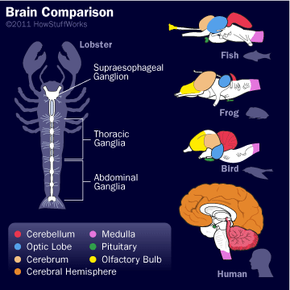Brain Parts
The simplest possible creatures have incredibly basic nervous systems made up of nothing but reflex pathways. For example, flatworms and invertebrates don't have centralized brains. They have loose associations of neurons arranged in straightforward reflex pathways. Flatworms have neural nets, or individual neurons linked together that form a net around the entire animal.
Most invertebrates (such as the lobster) have modest "brains" that consist of localized collections of neuronal cell bodies called ganglia. Each ganglion controls sensory and motor functions in its segment through reflex pathways, and the ganglia are linked together to form a simple nervous system. As nervous systems evolved, chains of ganglia evolved into more centralized simple brains.
Advertisement
Brains evolved from ganglia of invertebrates. Regardless of the animal, brains have the following parts:
- The brain stem, which consists of the medulla (an enlarged portion of the upper spinal cord), pons and midbrain (lower animals have only a medulla). The brain stem controls the reflexes and automatic functions (heart rate, blood pressure), limb movements and visceral functions (digestion, urination).
- The cerebellum integrates information from the vestibular system that indicates position and movement and uses this data to coordinate limb movements.
- The hypothalamus and pituitary gland are responsible for visceral functions, body temperature and behavioral responses such as feeding, drinking, sexual response, aggression and pleasure.
- The cerebrum (also called the cerebral cortex or just the cortex) consists of the cortex, large fiber tracts (corpus callosum) and some deeper structures (basal ganglia, amygdala and hippocampus). It integrates info from all of the sense organs, initiates motor functions, controls emotions and holds memory and thought processes (emotional expression and thinking are more prevalent in higher mammals).
